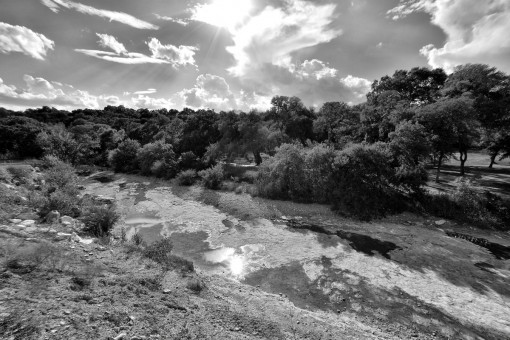A City of Few Fountains
February 8, 2014 | By Shoal Creek Conservancy
This blog post was written by Ted Lee Eubanks. To learn more about the author, please visit this site.

Great cities have great public spaces. Great public spaces often have great fountains. Where are Austin’s? Where’s the water? The drought has laid waste to the few that we have, I suspect.
The new Liz Carpenter fountain in Butler Park is functional, but most of our water features are bone dry. The discrete water feature in Republic Square (the one the kids loved to play in during the heat of summer) is about to be decommissioned. Wooldridge Square has been dry for decades. The Littlefield Fountain on the UT campus is dry more often than wet. Littlefield originally intended the fountain as a memorial to the Confederacy, which was criticized even when first proposed, but now honors University of Texas students who gave their lives in the Great War, and is situated at the South Mall end of the walkway to the UT Tower.
Austin has never had many fountains. Austin’s great public spaces reflect its hardscrabble past. My theory is that Austin’s meager existence left us a minimalist vision of a city. Investments in cultural improvements and grand public spaces seemed completely out of place (and financially impossible) in our cedar-treed, white-rocked poverty. Austin would be without the few public spaces that we do enjoy, such as Emma Long Metropolitan Park and Zilker Metropolitan Park, if not for the federal investments during the New Deal.
This low rent approach to city government and amenities kept Austin an inexpensive place to live for much of its history. The “Keep Austin Weird” era is a direct result of this low cost of living. Artists and musicians found Austin to be a cheap place to locate. Buildings were inexpensive to rent, and housing affordable. Keep Austin Weird, that era of the Armadillo World Headquarters and Eeyore’s Birthday, set the stage for the prosperity that we enjoy today. This prosperity propels us into the twenty-first century.
Part of our low rent history is a simplicity that many find appealing. Austin is the most informal big city in the country, perhaps in the world. Yet I believe that we can be as culturally advanced as any city and retain our ethos. We don’t have to dress up with ostentatious displays. But our parks and open spaces at this moment aren’t just simplistic, they are shoddy and cheap.
We can be true to the Austin spirit yet advanced in our approaches and public investments. We can develop fountains that are organic in their design, low in water and power consumption, yet are as valued by the community as any fountains in the world. The same is true for trails, parks, open spaces, performance venues, and the like.
Austin is one of the first great cities of the twenty-first century. Our maturation has been delayed for over a century. Now we can demonstrate what it means be to be a twenty-first century city. We can invest in cultural refinements that are as sophisticated as any in the world yet that are sensitive to sustainability as well.
We do not have to turn off the fountains when the water runs low. We can simply invent new fountains.
